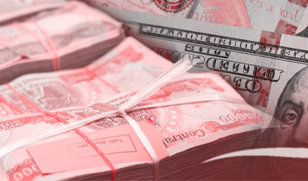 2022 / 05 / Dec
2022 / 05 / Dec
The economic repercussions of returning the exchange rate to the Iraqi dinar
Kamel Allawi Kazem Al-Fatlawi
University of Kufa / College of Administration and Economics
Foreword
Oil revenues constitute the main source of receipts in the balance of current operations, and constitute more than 90 percent of the revenues of the state’s general budget, in addition to contributing to about half of the gross domestic product. The interest rate does not play a role in the movement of capital or in the demand for foreign currency, and it finances the deficit In the general budget, from indirect borrowing from the Central Bank, which accumulated treasury transfers and became solid debts (although the Central Bank enjoys independence and is prohibited from lending to the government directly or indirectly according to Article 26 of its Law 56 of 2004), because other sources of financing ineffective, represented by taxes, internal and external borrowing, and cash issuance,
Exchange rate management
Article / 4 / 1 defines the functions of the Central Bank of Iraq (by formulating and implementing monetary policy, including the exchange rate), and the bank succeeded in controlling inflation rates by influencing the money supply through the currency sale window, as that rate decreased from 53.2 percent to That it became negative (2.8) percent in 2009 and reached 5.3 percent in 2021 after changing the exchange rate, which is a rate that does not raise concerns, and initially worked to strengthen the Iraqi currency after it lost confidence in it before 2003 and its loss of its most important function, which is a store of value. The exchange rate decreased from 1487 dinars / dollars in 2003 to 1166 dinars / dollars in 2014, to return to the rise until it reached 1304 dinars / dollars in December 2020, and that the bank worked on a policy of strengthening the Iraqi dinar, a policy that is not supported by any experience While the devaluation of the currency (raising the exchange rate) can be employed to improve development performance.
By tracking the development of the exchange rate, we find that it is stable and that the Central Bank defends it with foreign reserves, and this made prices a function of fluctuations in oil prices.
After the victory over the terrorist organization (ISIS), Iraq concluded credit standby agreements with the International Monetary Fund for the period 2016-2019. The first discussion took place on July 7, 2016, and the second discussion took place on June 24, 2016, and the Executive Board of the Fund approved the credit standby agreement with Iraq. At a value of $5.34 billion, which constitutes 230 percent of Iraq's share in the fund; This came to support economic reform, and Iraq received $1.24 billion in July 2015 through the Rapid Financing Instrument. The economic reform program aims to bridge the deficit in the balance of payments to comply with oil price changes, achieve debt sustainability, protect the poor, support economic stability, financial sector stability, and reduce corruption. This program is supported by the international community ().
Contrary to economic logic, the fund emphasized maintaining the fixed exchange rate as a fundamental pillar, while the state of the economy requires that the exchange rate be flexible to expose the country to the double shock, or to move within certain limits. The justification of the fund at the time was that the social consequences would be great.
The fund believes that reducing the Iraqi dinar to face the crisis and absorb the external shock does not give the desired results. Because of the inflexibility of exports, so the reduction will have little effect, and it is necessary to resort to fiscal consolidation instead.
Justifications for raising the exchange rate in December 2020
Iraq was subjected to a triple shock represented by the political shock produced by the October uprising, the resignation of the government of Mr. Adel Abdul Mahdi, the health shock created by the Covid-19 pandemic, and the shock of the collapse of oil prices. Oil prices fell in the global market until, at a certain moment, they became negative, which is the first time in history. Economic, as for Iraqi oil prices, they reached their lowest level in April 2020; As it amounted to 13,801 dollars / barrel, and it rose due to the partial closure to confront the repercussions of Corona to 47,765 dollars / barrel, this situation led to a decline in oil revenues, which are the main source of funding for the state’s general budget, which forced the government to resort to internal and external borrowing to finance the budget deficit, and borrowing led to The Ministry of Internal Affairs raised the monetary mass issued from 51.835 trillion dinars in December 2019 to 66.031 trillion dinars in December 2020, and as a result, the demand for the dollar increased and foreign reserves decreased rapidly due to the decline in oil revenues, which are the main source of the dollar.
On the other hand, the Iraqi economy faces two types of imbalances, in addition to other imbalances. The external imbalance, represented by the current account deficit to the gross domestic product, which amounted to about 20%, which means the deterioration of the parallel real exchange rate through the decline in foreign currency sales through the currency sale window, as well as the decrease in government sales to the Central Bank of hard currency in addition to the pessimistic expectations that prevailed About the Iraqi dinar. As for the internal imbalance, it is represented by the general budget deficit during the year 2020, which was directly financed through internal borrowing, to reach about 27 trillion, which put great pressure on the value of the local currency. In view of this situation, the concerned authorities had no choice but to intervene to contain these two imbalances by devaluing the local currency, in order to address the double deficit in the current account, which is correlated with the general budget deficit, for the purpose of maintaining foreign reserves within their safe limits relative to the exported currency, in addition to the high The exchange rate will provide the government with additional revenues to finance the government deficit, and on the other hand, it will reduce sales of dollars to reduce imports because local prices will be cheaper than imported prices (), but it must be emphasized that changing the exchange rate is a correct policy, but the timing and size are incorrect .
Re-exchange rate: an economic point of view
Some economists and politicians argue about the need to raise the value of the currency (reducing the exchange rate) to what it was before December 2020, i.e. 1200 dinars / dollars. Arguments are made related to the high rates of inflation, economic growth and social justice. In short, a major change occurred at the beginning of raising the exchange rate, but it It soon returned to around 5.3 percent in December 2021, but in 2022 the rise in inflation rates is due to the state of the global economy due to the Russian-Ukrainian war. As for the rate of economic growth, growth in Iraq is achieved due to the improvement in the oil sector, so the second largest economic growth rate in the world has been achieved by more than 9 percent, and the first in the Arab world, but this rate does not properly disclose the state of the Iraqi economy because it is a rentier economy that suffers from chronic structural imbalances, in addition to the fact that the appreciation of the currency means a decrease in competitiveness; Hence, it negatively affects economic growth, so this argument is unacceptable. As for the fragile groups, the government must face the repercussions of raising the exchange rate of the dinar, as they are the most benefiting from raising the exchange rate, which is estimated at 25 trillion dinars. And it must activate the social protection network in a sound way, away from corruption, and work to redistribute income in favor of the poor classes, in addition to controlling the ration card.
What happens if the exchange rate is changed (currency appreciation)
1- Reducing the exchange rate of the dinar (raising the value of the currency) means a decrease in competitiveness, and local goods become more expensive than foreign goods, and this adds an additional burden to the economy; Because the economic sectors become unable to compete, and although the local supply is inflexible, a confrontational measure remains necessary.
2- On the other hand, decreasing the exchange rate of the dinar (raising the value of the currency) will lead to a significant increase in imports; Because the trading partners (Turkey and Iran) have devalued their currencies to counter the action taken by the Central Bank in late 2020; Hence, decreasing the exchange rate will be in their interest, as it will bring them benefits and Iraq will have losses.
3- The business sector bases its decisions on expected prices and the present value of future returns. Therefore, the stability of the exchange rate leads to an improvement in the investment environment and helps businessmen to build their expectations properly.
4- Changing the exchange rate in short periods gives a negative indication of the country's classification for obtaining loans on concessional terms.
5- Changes in exchange rates lead to confusion in the markets and the financial system as a whole, and thus lead to price distortion.
6- Article 2 of the Central Bank Law stipulates that it is independent and does not receive any instructions from any entity. Therefore, political influences seeking to interfere in the work of the bank are a violation of its independence and weaken its credibility and ability to achieve monetary stability.
7- Linking the exchange rate to oil revenues means opening a new channel to transmit external shocks to the local economy.
8- The repetition of changing the exchange rate is an incentive to speculate on the currency, and then leads to a shift to real assets, which affects their prices, in addition to leading to a widening of the gap between the official exchange rate and the parallel exchange rate.
9- Returning the exchange rate to what it was, means losing more than 20 trillion dinars from public revenues; It is a huge amount that the budget may not bear in light of the increasing expenditures and the uncertainty in the direction of oil prices.
10- Raising the value of the local currency (the dinar) requires defending it (in light of the stability of the exchange rate) with reserves, which leads to its erosion, and this affects the monetary and financial situation of the country.
11- The argument that reducing the exchange rate will lead to a decrease in the rate of inflation is inaccurate. Because historical experience confirms that prices do not return to what they were.
12- Working to raise the value of the Iraqi dinar against the dollar will lead to more workers working for trade partners and increasing unemployment in the Iraqi economy.
13- Reducing the exchange rate will lead to an increase in the Iraqis’ demand for services (health, education, tourism and travel…) abroad, i.e. draining the balance of foreign currency.
In sum, restoring the exchange rate to what it was has dire consequences for the economy at the present time and in the near future, if we know that the value of the dinar is still higher than its real value, and that a proposal to move the exchange rate was submitted when the situation was appropriate in 2014. The management of the Central Bank rejected the proposal under the pretext of its impact on the poor, but it returned and moved the exchange rate at an inappropriate time and size.

Dr.. Kamel Allawi Kazem Dr.. Kamel Allawi Kazem